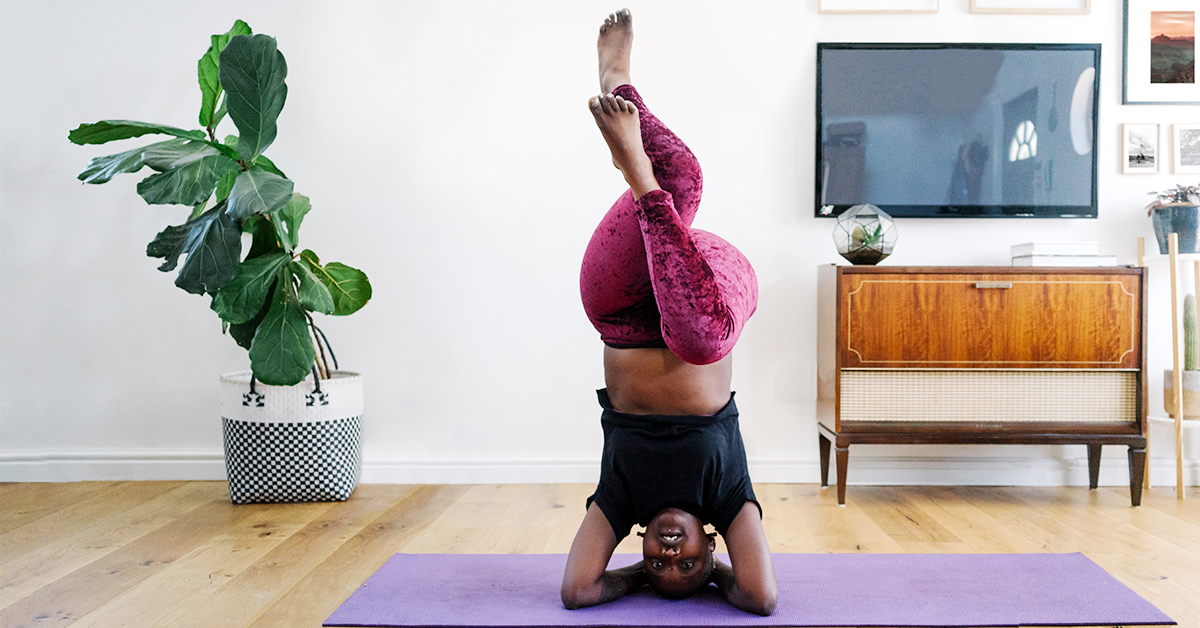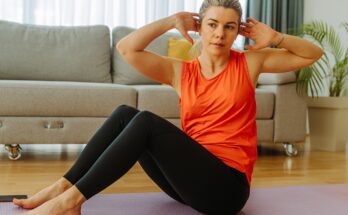After countless yoga classes of all styles at studios far and wide, one question continues to bug me: Why do some yoga instructors tell women not to do inverted poses during their period?
Don’t get me wrong — I’m happy to lay on my mat in Child’s Pose while the rest of the class contorts their bodies into upside down pretzels (kudos to you if you have the body control to do inversions in the first place!). But is there any legitimate medical risk involved in doing certain poses during your period? Or is it as outdated an idea as female hysteria?
To invert or not to invert… that is the question.
The reasons some yoga teachers suggest avoiding inversions such as handstands, headstands, and shoulder stands are based on both yogic tradition and a potentially increased risk of endometriosis.
Philosophically, in yoga, menstruation is considered to be apana, meaning your body’s energy is downward-flowing. Those against inversions say that the poses will disturb the natural energetic flow, so it’s better to avoid putting your uterus in the air or upside down
Don’t get me wrong — I’m happy to lay on my mat in Child’s Pose while the rest of the class contorts their bodies into upside down pretzels (kudos to you if you have the body control to do inversions in the first place!). But is there any legitimate medical risk involved in doing certain poses during your period? Or is it as outdated an idea as female hysteria?
To invert or not to invert… that is the question.
The reasons some yoga teachers suggest avoiding inversions such as handstands, headstands, and shoulder stands are based on both yogic tradition and a potentially increased risk of endometriosis.
Philosophically, in yoga, menstruation is considered to be apana, meaning your body’s energy is downward-flowing. Those against inversions say that the poses will disturb the natural energetic flow, so it’s better to avoid putting your uterus in the air or upside down.
Energy flow, though, isn’t a medical condition — endometriosis is.
According to Dr. Kecia Gaither, OB/GYN, endometriosis is a condition in which cells like those that line the uterus (the stuff you shed during your period) implant themselves outside the uterus, causing inflammation, scarring, infertility, and pain.
“No definitive cause for endometriosis has been found,” Gaither says. “There are a number of hypotheses or associations, including retrograde menstruation, genetics, hormonal imbalance, or a relation to a uterine anomaly.”
Women are warned that if their bodies are upside down, the blood flow will go backward instead of down and out, causing what’s known as retrograde menstruation, and possibly later lead to endometriosis.
Renowned yogini Gina Caputo says, “The expulsion of the uterine lining during menstruation isn’t propelled by gravity, but by uterine contractions. So, while there are no universally applicable medical reasons to avoid inverting your body during menstruation, every woman should consult a healthcare professional who knows their reproductive history and current condition when deciding whether or not it makes sense for them to do so.”
Retrograde menstruation, as it turns out, is experienced by an estimated 90% of women —yet only 1 in 10 women are diagnosed with endometriosis. Since the causes of endometriosis aren’t nailed down, it may not make sense to rule out inversions on a medical basis.
Gaither says, “Since there hasn’t been a distinct identifiable cause of the disorder, to restrict women afflicted with endometriosis from certain yoga positions would be a cautionary approach at best.”
Another theory is that inversions while menstruating might cause “vascular congestion” in the uterus, causing excessive menstrual flow. This risk may be most relevant for women holding inversions for a lengthy amount of time (like, longer than a tampon commercial, which most of us probably don’t do).
“Yoga may have an impact on a person’s autonomic nervous system,” explains Caputo. “If the challenges of excessive flow and irregularity are related to, for example, a person’s stress and anxiety, it’s entirely possible that yoga would be helpful. But simply stretching and contracting tissues, as we do in physical yoga practice, are very unlikely to impact excessive flow and irregularity.”
So, at this point, the idea that yoga inversions could cause endometriosis are mere speculation from a medical point of view. As for philosophical reasons within the realm of yoga, there are differing opinions on whether inversions may improve elimination of excess apana.









